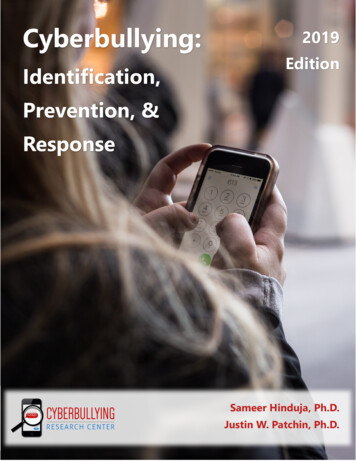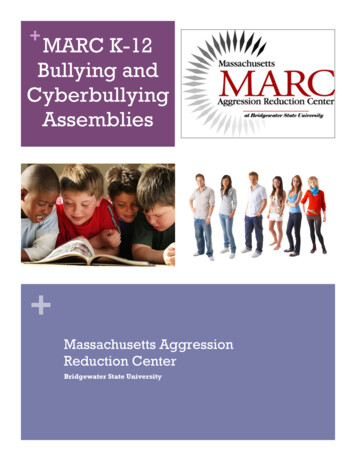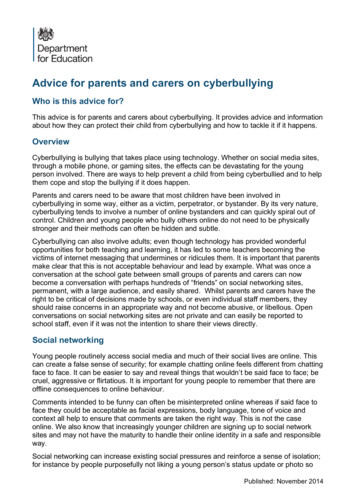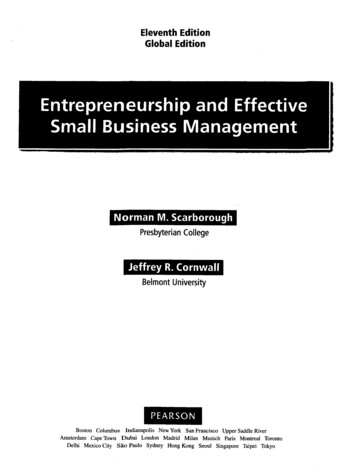
Transcription
, &ResponseSameer Hinduja, Ph.D.Justin W. Patchin, Ph.D.1
Ymakes me feel sick and worthless.” Those who arevictimized by cyberbullying also reveal that they areoften afraid or embarrassed to go to school. In addition, research has revealed a link between cyberbullying and low self-esteem, family problems, academic difficulties, school violence, and various delinquent behaviors. Finally, cyberbullied youth alsoreport having suicidal thoughts, and there havebeen a number of examples in the United Statesand abroad where youth who were victimized ended up taking their own lives.outh have been bullying each other for generations. The latest generation, however, hasbeen able to utilize technology to expandtheir reach and the extent of their harm. This phenomenon is being called cyberbullying, defined as:“willful and repeated harm inflicted through the useof computers, cell phones, and other electronic devices.” Basically, we are referring to incidents whereadolescents use technology to harass, threaten, humiliate, or otherwise hassle their peers. For example, youth can send hurtful texts to others or spreadrumors using smartphones or tablets. Teens havealso created web pages, videos, and profiles on social media platforms making fun of others. Withmobile devices, adolescents have taken pictures ina bedroom, a bathroom, or another location whereprivacy is expected, and posted or distributed themonline. Others have recorded unauthorized videosof their peers and uploaded them for the world tosee, rate, tag, and discuss. Still others are embracing anonymous apps or the interactive capabilitieson gaming networks to tear down or humiliate others.Where does cyberbullying commonly occur?Cyberbullying occurs across a variety of venues andmediums in cyberspace, and it shouldn’t come as asurprise that it occurs most often where adolescents congregate. In the early 2000s, many kidshung out in chat rooms, and as a result that iswhere most harassment took place. In recent years,most youth are have been drawn to social media(such as Instagram, Snapchat, TikTok/Musical.ly,and Twitter), voice/text chat in popular games(Roblox, League of Legends, Overwatch, PlayerUnknown Battlegrounds, Fortnite) and videosharing and streaming sites (such as YouTube,Twitch, and Live.Me). This trend has led to increased reports of cyberbullying occurring in thoseenvironments. We are also seeing it happen in augmented reality (AR) and virtual reality (VR) environments, in social gaming sites, and in anonymousapps that come and go on a regular basis.What are some negative effects that cyberbullying can have on a person?There are many detrimental outcomes associatedwith cyberbullying that reach into the real world.First, many targets report feeling depressed, sad,angry, and frustrated. As one teenager told us: “Itmakes me hurt both physically and mentally. Itscares me and takes away all my confidence. It2
Cyberbullying by the numbersher identity using anonymous email addresses orpseudonymous screen names. Second, the hurtfulactions of those who cyberbully can go viral; that is,a large number of people (at school, in the neighborhood, in the city, in the world!) can participate inthe victimization, or at least find out about the incident with a few keystrokes or touchscreen impressions. It seems, then, that the pool of potential targets, aggressors, and witnesses/bystanders is limitless.Estimates of the number of youth who experiencecyberbullying vary widely (ranging from 10-40% ormore), depending on the age of the group studiedand how cyberbullying is formally defined. In ourresearch, we inform students that cyberbullying iswhen someone “repeatedly makes fun of anotherperson online or repeatedly picks on another person through email or text message or when someone posts something online about another personthat they don’t like.” Using this definition, about28% of the students who have been a part of ourmost recent 10 studies over the last decade havesaid they have been the victim of cyberbullying atsome point in their lifetime. About 16 percent admitted to cyberbullying others during their lifetime.In our most recent study of a nationallyrepresentative sample of approximately 5,700 middle and high schoolers in the U.S., 33.8 percent saidthey had been cyberbullied during their lifetime,while 16.9 percent said they had been cyberbulliedwithin the previous 30 days. With regard to offending, 11.5 percent revealed they had cyberbulliedothers during their lifetime, while 6.0 percent admitted doing so in the last 30 days.Third, it is often easier to be cruel using technologybecause cyberbullying can be done from a physically distant location, and the aggressor doesn’t haveto see the immediate response by the target. Infact, some teens simply might not realize the serious harm they are causing because they are sheltered from the victim’s response. Finally, while parents and teachers are doing a better job supervisingyouth at school and at home, many adults don’thave the technological know-how (or time) to keeptrack of what teens are up to online. As a result, atarget’s experience may be missed and a aggressor’s actions may be left unchecked. Even if thosewho bully are identified, many adults find themselves unprepared to adequately respond.Why is cyberbullying becoming a majorissue?Cyberbullying vs. traditional bullyingWhile often similar in terms of form and technique,cyberbullying and bullying have many differencesthat can make the latter even more devastating.With the former, victims may not know who is targeting them, or why. The aggressor can cloak his orCyberbullying is a growing problem because increasing numbers of kids are using and have completely embraced online interactivity. A remarkable95% of teens in the U.S. are online, and the vast3
true that there are many issues facing adolescents,parents, teachers, and law enforcement today, wefirst need to accept that cyberbullying is one suchproblem that will only get worse if ignored.majority access the internet on their mobile device.They do so for school work, to keep in touch withtheir friends, to play games, to learn about celebrities, to share their creations, or for many other reasons. Because online communication tools have become such a tremendous part of their lives, it is notsurprising that some youth have decided to use thetechnology to be malicious or menacing towardothers. The fact that teens are constantly connectedto technology means they are susceptible to victimization (and able to act on mean impulses towardothers) around the clock. And because some adultshave been slow to respond to cyberbullying, manyfeel that there are little to no consequences fortheir actions. Many even feel that there is littlechance of detection and identification, let alonesanction.The other challenge relates to who is willing to stepup and take responsibility for responding to inappropriate use of technology. Parents often say thatthey don’t have the knowledge or time to keep upwith their kids’ online behavior, and that schoolsshould be covering it in detail during class time andthrough other programming. Educators are oftendoing their part through policies, curricula, training,and assemblies, but sometimes don’t know whenand how to intervene in online behaviors that occuraway from school but still involve their students.Finally, law enforcement is hesitant to get involvedunless there is clear evidence of a crime or a significant threat to someone’s physical safety. As a result,cyberbullying incidents either slip through thecracks, are dealt with too formally, are dealt withtoo informally, or are otherwise mismanaged. Atthat point, the problem behaviors can continue andeven escalate because they aren’t adequately orappropriately addressed.Cyberbullying crosses all geographical boundaries.Online connectivity across a broad variety of devices has opened up the whole world to users, and forthe most part this has been a good thing (a reallygood thing!). Nevertheless, some kids feel free topost or send whatever they want while online without considering how that content can cause harm.Based on these challenges, we need to create anenvironment where all youth feel comfortable talking with adults about this problem and feel confident that meaningful steps will be taken to resolvethe situation. We also need to get everyone involved - kids, parents, educators, counselors, youthleaders, law enforcement, social media companies,and the community at large. It will take a concertedand comprehensive effort from all stakeholders tomake a meaningful difference in reducing cyberbullying.Obstacles in the fight to stop cyberbullyingThere are two primary challenges today that makeit difficult to prevent cyberbullying. First, eventhough this problem has been around for almosttwo decades, some people still don’t see the harmassociated with it. Some attempt to dismiss or disregard cyberbullying because there are “more serious forms of aggression to worry about.” While it is4
“Today my best friends turned on me and put my business on social mediaand I can't believe why! I told them who I liked and they took and postedour conversation.I didn’t want to fight back but I did and one of my friendstold everyone the guy I like told her he would never date me and noweveryone knows :( now everyone's calling me dirty and a slut.”The role of parentsearly in their exploration of cyberspace. This can bedone informally (through active participation inyour child’s internet experience, which we recommend most of all) and formally (through software).Spying on kids and unnecessarily invading their privacy should only be done as a last resort whenthere is a significant cause for concern. Honest andopen monitoring is a part of a healthy parent-childrelationship. Spying conveys distrust and may encourage youth to go further underground.The best tack parents can take when their child iscyberbullied is to make sure they feel (and are) safe,and to convey unconditional support. Parents mustdemonstrate to their children through words andactions that they both desire the same end result:that the cyberbullying stop and that life does notbecome even more difficult. This can be accomplished by working together to arrive at a mutuallyagreed upon course of action, as many times it isappropriate (and important) to solicit the child’sperspective as to what might be done to improvethe situation. It is so critical not to be dismissive oftheir perspective, but to validate their voice andperspective. Targets of cyberbullying (and thosewho observe it) must know for sure that the adultswho they tell will intervene rationally and logically,and not make the situation worse.In time, parents will need to give their childrenmore freedom, privacy, and responsibility. They willnot be able to monitor their child’s activities 24/7,nor should they need to do so. As a result, it is crucial that parents cultivate and maintain an open,candid line of communication with their children, sothat they are inclined to reach out when they experience something unpleasant or distressing online.Reinforce positive morals and values about howothers should be treated with respect and dignity.Point out models to emulate in society, and use viral mistakes made by other youth and adults asteachable moments.If it is deemed necessary, parents should explain theimportance of scheduling a meeting with schooladministrators (or a teacher they trust) to discussthe matter. Parents may also be able to contact thefather or mother of the offender, and/or work withthe Internet Service Provider, Cell Phone ServiceProvider, or Content Provider to investigate the issue or remove the offending material (many times,the victim simply wants the content or account deleted so they can move on with their life). The police should also be approached when physicalthreats are involved or a crime has possibly beencommitted (extortion, stalking, blackmail, sexualexploitation of minors, etc.).Resilience - the skill to bounce back after facing adversity - is also important to cultivate with intentionat this stage. Instead of swooping in and rescuingkids from all of their social and relational struggles,help them hone the ability to deflect, disrupt, dispute, shrug off, or otherwise ignore hurtful thingsthat others say or post. This can occur by helpingthem internalize positive beliefs (rather than selfdefeating thoughts) after being cyberbullied, or byspotlighting relatable overcomers in books andmovies with whom they can connect.Overall, parents must educate their kids about appropriate online behaviors just as they convey appropriate offline behaviors. They should also monitor their child’s activities while online – especiallyParents may also utilize an age-appropriate“Technology Use Contract” to foster a crystal-clear5
is essential that parents pay even greater attentionto the technology use of their child to make surethat they have internalized the lesson and are continually acting in responsible ways. Not only shouldthey not be doing the wrong thing, they should bedoing the right thing online!understanding about what is and is not appropriatewith respect to the use of various devices andonline communication tools. To remind the child ofthis pledged commitment, we recommend that thiscontract be posted in a highly visible place at home.When there are violations, immediate logical consequences must be given that are proportionate tothe misbehavior. Kids need to learn that inappropriate online actions will not be tolerated. Get them tounderstand that technology use and access is aprivilege, and not a right—and with those privilegescomes certain responsibilities that must be respected.What should schools do to prevent cyberbullying?The most important preventive step that schoolscan take is to educate the school community aboutresponsible use of their devices at all times (ideallythrough a concerted focus on digital citizenship responsibilities). Students need to know that all formsof bullying are wrong and that those who engage inharassing or threatening behaviors will be subjectto discipline. It is therefore essential to discuss issues related to appropriate online communicationsin various areas of the general curriculum. To besure, these messages should be reinforced in classes that regularly utilize technology. Signage alsoshould be posted around campus to remind students of the rules of acceptable use. In general, it iscrucial to establish and maintain an environment ofrespect and integrity where violations result in informal or formal sanction.If a parent discovers that their child is cyberbullyingothers, they should first communicate how that behavior inflicts harm and causes pain in the realworld as well as in cyberspace. We must rememberthat kids are not sociopaths—they are just kids whosometimes lack empathy and make mistakes. Thatsaid, there are ramifications for every choice theymade. Depending on the level of seriousness of theincident, and whether it seems that the child hasrealized the hurtful nature of his or her behavior,consequences should be firmly applied (and escalated if the behavior continues). Moving forward, it“I like the way they [my school] handled itbecause they treated me with respect andFurthermore, school district personnel should review their harassment and bullying policies to ensure that it allows for the discipline of students whoengage in cyberbullying. If their policy covers it,did not laugh at the situation.They took it seriously.”6
cyberbullying incidents that occur at school - orthat originate off campus but ultimately result in asubstantial disruption of the learning environment are well within a school’s legal authority to intervene. The school then needs to make it clear to allstakeholders. In some cases, simply discussing theincident with the offender’s parents will result in thebehavior stopping.and the disruption that occurred.Moreover, schools should come up with creativeresponse strategies, particularly for relatively minorforms of harassment that do not result in significantharm. For example, students may be required tocreate anti-cyberbullying posters to be displayedthroughout the school, or a public service announcement (PSA) video conveying an anti-bullyingand/or a pro-kindness message. Older studentsmight be required to give a brief presentation toyounger students about the importance of usingtechnology in ethically-sound ways. The point here,again, is to condemn the behavior (without condemning the child) while sending a message to therest of the school community that bullying in anyform is wrong and will not be tolerated.A youth may be being cyberbullied if he or she: unexpectedly stops using their device(s) appears nervous or jumpy when using device(s) appears uneasy about being at school or outside appears to be angry, depressed, or frustrated after texting,Even though the vast majority of these incidentscan be handled informally (calling parents, counseling the aggressor and target separately, expressingcondemnation of the behavior), there may be occasions where formal response from the school iswarranted. This is particularly the case in incidentsinvolving serious threats toward another student, ifthe target no longer feels comfortable coming toschool, or if cyberbullying behaviors continue afterinformal attempts to stop it have failed. In thesecases, detention, suspension, changes of placement,or even expulsion may be necessary. If these extreme measures are required, educators must clearly articulate the link to school and present evidencethat supports their action.chatting, using social media, or gaming becomes abnormally withdrawn avoids discussions about their activities onlineA youth may be cyberbullying others if he or she: quickly switches screens or hides their device uses their device(s) at all hours of the night gets unusually upset if they can’t use device(s) avoids discussions about what they are doing online seems to be using multiple online accounts, or an accountthat is not their ownIn general, if a child acts in ways that are inconsistent with theirusual behavior when using these devices, find out why.Cyberbullying and school climateThe benefits of a positive school climate have beenidentified through much research over the last thirty years. It contributes to more consistent attendance, higher student achievement, and other desirable student outcomes. Though limited, researchdone on school climate and traditional bullying alsounderscores its importance in preventing peer conflict. One of our recent studies found that studentswho experienced cyberbullying (both those whowere targets and those who admitted to cyberbullying others) perceived a poorer climate at theirschool than those who had not experienced cyber-What should schools do to respond tocyberbullying?Students should fully understand that cyberbullyingwill result in discipline, and our recent researchshows that this known potential has a meaningfuldeterrent effect on youth. Utilize school liaison officers or other members of law enforcement tothoroughly investigate incidents, as needed, if thebehaviors cross a certain threshold of severity. Oncethe offending party has been identified, develop aresponse that is commensurate with the harm done7
What can youth do?bullying. Youth were asked whether they “enjoy going to school,” “feel safe at school,” “feel that teachers at their school really try to help them succeed,”and “feel that teachers at their school care aboutthem.” Those who cyberbullied others or who werethe target of cyberbullying were less likely to agreewith those statements.First and foremost, youth should develop a relationship with an adult they trust (a parent, teacher, orsomeone else) so they can talk about any experiences they have online (or off) that make them upset or uncomfortable. If possibl
dition, research has revealed a link between cyber-bullying and low self-esteem, family problems, aca-demic difficulties, school violence, and various de-linquent behaviors. Finally, cyberbullied youth also report having suicidal thoughts, and there have been a number of examples in the Unit











